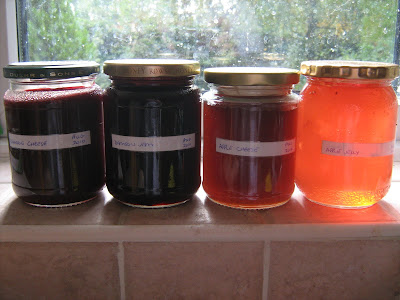YAWA: Jam, Jelly and Cheese

Whenever I write about my jam making activities, there's always a bit of a stir (ha ha!) because it's a term not very well known across the pond. There jelly is the main preserve, which for us here usually means a very wibbly wobbly pudding instead. My opus on damsons confused matters still further by referring to cheese, which in this context has absolutely nothing to do with milk products. It also seems anything I write about jam becomes a massive hit with search engines (see the Popular Posts section on the right sidebar), therefore it was only a matter of time before the You Ask, We Answer team tackled this topic.
The picture shows some of the latest produce from my preserving activities: from left to right we have damson cheese, damson jam, apple cheese and apple jelly. This was an attempt to show you some of the visual differences between the products. It's worked better with the apple as you can see the cheese is much darker than the clear, almost jewel-like jelly.
All of the jars contain the same basic ingredients: good quality fruit plus water and sugar (sometimes lemon is also needed if the fruit alone is insufficient for a good set), but the method used to reach the end result differs slightly. Jam and cheese are both made from whole fruit cooked together with the other ingredients in a pan in one go. Jelly is a two step process and uses just the juice from the cooked fruit. This is separated from the pulp by leaving the cooked fruit in a jelly bag (or similar) overnight to gradually drip into a bowl. The juice is then combined with the sugar and reheated until set point is reached, as for jam. It means that jam and jelly have a similar thickness, but quite a different texture.
Cheese is like a very thick version of jam, where the fruit, sugar and water are boiled down way past the set point, until the bottom of the saucepan can be seen for a short while when the mixture is scraped through with a spoon. However, it's not usually served in the same way: jam is a teatime favourite spread onto bread and butter; or used as a filling to sandwich together sponge cakes; or to keep marzipan on top of a cake. Cheese is usually a more savoury affair, being served with cold meat or even the other kind of cheese. Jelly can be used as either a sweetmeat or a savoury accompaniment; quite often it's used as the latter when herbs are added to the ingredients list.
Jam yields the most because nothing gets thrown away and it has less of its water content boiled off. It looks like cheese and jelly yield about the same judging by my apple preserving activities this year. This might be worth taking into consideration depending on the amount of fruit you have to preserve - making cheese or jelly will rapidly swallow up quite a glut! Another consideration might be if you have problems with the teeny tiny pips of fruit like raspberries: then a jelly might be a better option for you.
This only dips a toe into the world of preserve terminology: there's butter, chutney, curd, marmalade and canning to consider, never mind a whole host of other things I've forgotten about. However, I think that's enough for now and I'll save those for another day.
The YAWA Dictionary: Adding meaning to your blogging










I'd never heard of fruit cheese until you posted about - I'm now on the look out for some to try, you will find me lurking around the WI produce stalls (not really)!!
ReplyDeleteare jelly/jello interchangeable terms? i much prefer jam as american jelly seems to be merely solidified sugar-water.
ReplyDeleteMost illuminating to me VP as I am an eater rather than a maker of such goodies. I am still in a pickle though ~ what is the definition of a preserve?
ReplyDeletePG - I think we might have a spare jar somewhere...
ReplyDeletePetoskystone - isn't Jello a brand name for jelly sold commercially?
Anna - lawd, one to hand over to the YAWA team I think...
I love jam - best stuff in the world I reckon. Except maybe whiskey.
ReplyDeleteAnd I finally - finally - sorted out the new house this week ; we move in at half term. There are walnut trees in the garden - so can you make walnut jam? (not a serious YAWA question) I think it's possible to pickle them. Did you get pics I sent you?
yes, jello is a brand name which is so widespread as to become the actual thing. at this point, 'jello' is more descriptive than 'gelatin dessert'. much like 'kleenex' is a brand name for facial tissue but is so widespread as to be one & the same.
ReplyDeleteMark - hope the move's going well. Will email you shortly :)
ReplyDeleteWe have the same thing here - everyone 'hoovers' even if they use a different brand of vacuum cleaner ;)